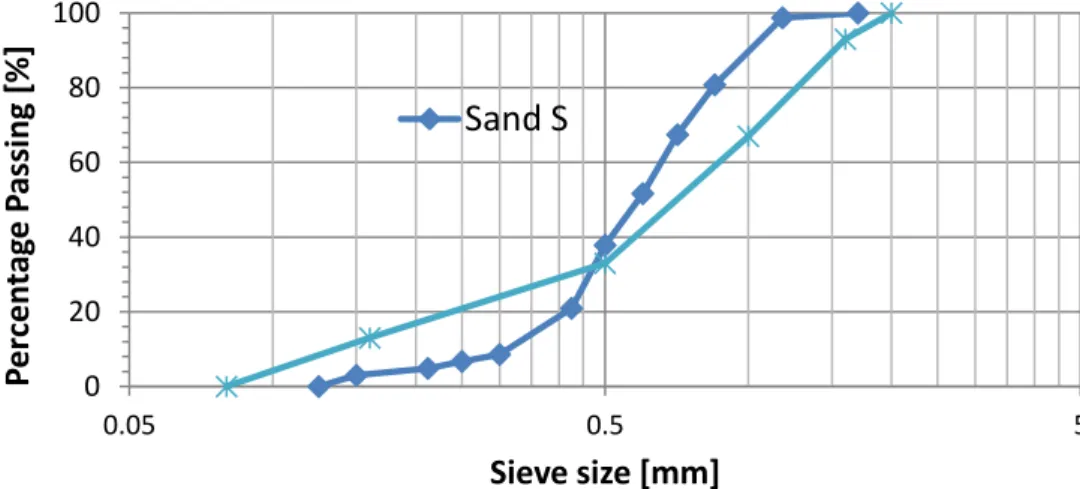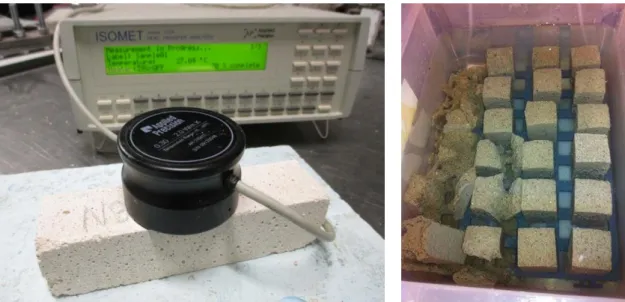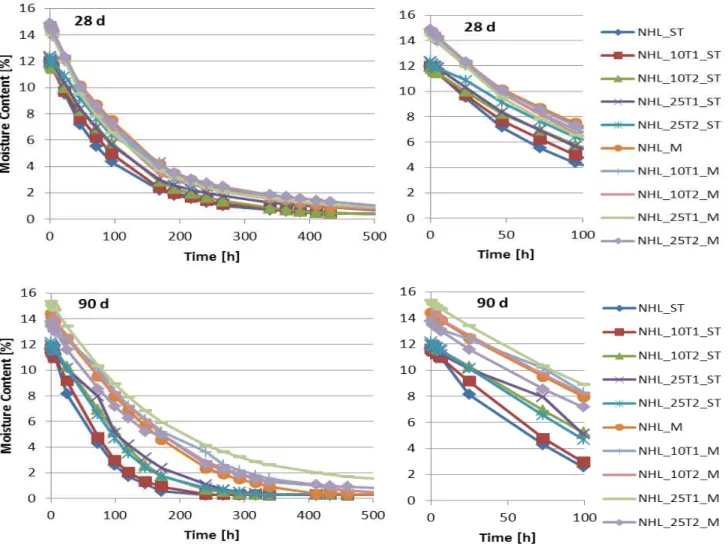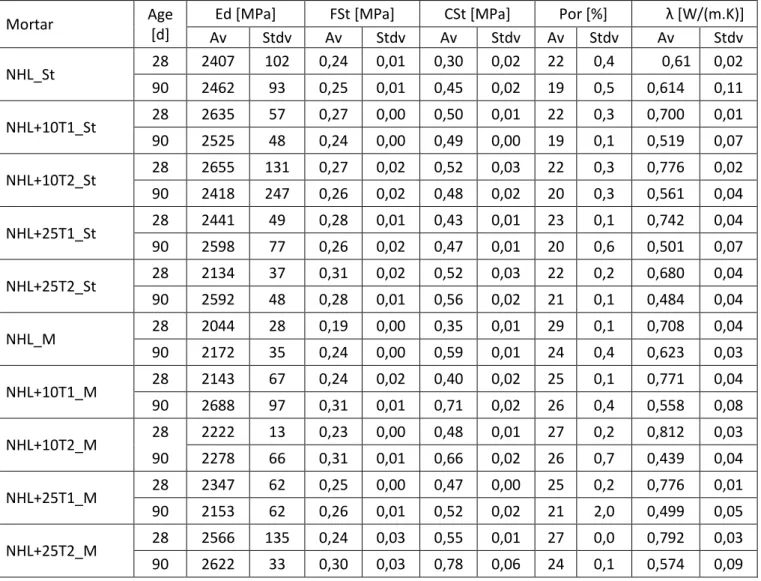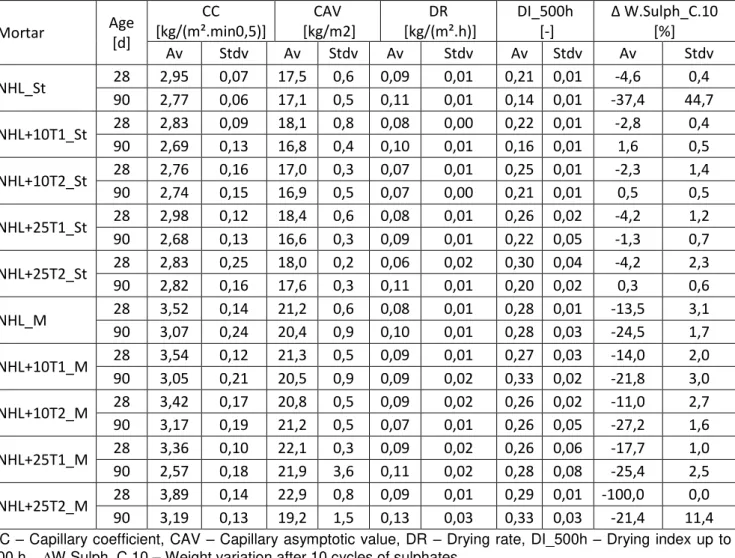Natural hydraulic lime mortars with ceramic wastes for
masonry
FARIA, PAULINA
1; SILVA, VITOR
2; MADEIRA, TIAGO
3ABSTRACT:
In Portugal natural hydraulic limes have recently been formulated to accomplish EN 459-1:2010 requirements and, for that reason, knowledge on mortars with that particular binder is still recent. With the downturn of the building sector and sustainable practices awareness, many ceramic factories and construction sites have had to reconsider the management of their wastes. Ceramic wastes were often used in the past as pozzolans of air lime mortars. Bearing these considerations in mind, mortars with low content of a natural hydraulic lime and additions of two ceramic wastes were formulated, cured in laboratory conditions and exterior environment and characterized by destructive and non-destructive methods. Aspects related to workability, mechanical resistances, water absorption, drying and resistance to sulphates´ attack are analysed. The viability and drawbacks of the addition of ceramic wastes to low binder content natural hydraulic lime-based mortars to be applied on masonries are highlighted.Keywords: NHL3.5, ceramic waste, mortar, curing, characterization
NOTATION
NHL3.5 Natural hydraulic lime classified by EN 459-1:2010
S Sand
T1 Ceramic waste from hollow contemporary bricks
T2 Ceramic waste from unglazed contemporary façade tiles
ρo Loose bulk density
Ed Dynamic modulus of elasticity FSt Flexural strength
CSt Compressive strength Por Open porosity
λ Thermal conductivity CC Capillary coefficient
CAV Capillary asymptotic value DR Drying rate
DI_500h Drying index up to 500 h
∆W.Sulph_C.10 Weight variation after 10 cycles of sulphates attack
1)
1 INTRODUCTION
In 2010 a new version of standard EN 459-1 [1] was published, redefining the requirements of building limes, namely the ones with hydraulic properties. In the previous version of the standard [2] natural hydraulic limes could have additions and low amounts of calcium hydroxide (Ca(OH)2); in the current version natural hydraulic limes can no longer have any additions and have to present a minimum amount of 15% of Ca(OH)2. The new version of the standard entered into force in Portugal in July 2012.
Portugal is one of the few countries where natural hydraulic limes are produced, from calcination, at temperature under 900ºC (according to information from the producer), of calcareous-clayish stone. With the new version of the standard, three new natural hydraulic limes were produced - NHL2, NHL3.5 and NHL5 - and some have been exported abroad. A NHL3.5 have to present a minimum amount of 25% of Ca(OH)2 and a maximum of 2% sulphates.
With the downturn of the building sector and sustainable practices awareness, many ceramic factories have had to reconsider their course of action, namely in terms of the management of their by-products and wastes, and construction sites have had to became more efficient in the management of their own wastes, namely the ceramic ones.
In the past, ceramic wastes were often used in air lime mortars - the finer particles as pozzolans and the coarser particles as aggregates. Many examples from the Roman Empire can still be found in archaeological sites [3, 4, 5]; others can be found in Byzantine masonry [6]. The use of ceramic with pozzolanic reactivity introduced a technological improvement. In fact they grant a hydraulic behaviour to air lime mortars, with an easier and faster hardening, along with a durability increase. That could be seen for instance when used in direct contact with water in aqueducts and baths. Simultaneously, that use of the ceramic particles was already a sustainable practice since broken ceramics (roof and floor tiles, bricks, domestic ware and amphorae used as food and drink reservoirs) were collected, crushed and reused as building material.
Natural hydraulic lime may be a possibility for more sustainable and compatible binders for use in new constructions but particularly for the rehabilitation of existent buildings and the conservation of historic masonry. Knowledge about the characteristics of grouts and mortars formulated with natural hydraulic limes accomplishing the requirements of standard EN 459-1 [1] is not yet frequent [7, 8], and particularly knowledge on mortars with the new NHL3.5 [1] have to be gained. Grilo et al. [9, 10] have studied the characteristics of mortars formulated with a first batch (from January 2012) of NHL3.5 from the same producer. Mortars had a volumetric proportion 1:3 (NHL3.5:sand), using a siliceous washed graded sand and considering a loose bulk density of NHL3.5 of 850 kg/m3. The characterization was made from prismatic samples under different types of curing, one of them according to EN 1015-11 [11] - first week at 95% relative humidity (RH), followed by 65% RH - and another one at natural marine environment, after a first week at 95% RH. Faria and Silva [12] characterized 1:3 (NHL3.5:sand) volumetric proportioned mortars with the same NHL3.5 and sand, and from the same batch, considering the same loose bulk density. They evaluated the influence of different types and particle size distribution of the aggregates, constituted by sands and eventually fillers, being one of them a fine fraction of a ceramic waste. Fontes et al. [13] characterized 1:3 (NHL3.5:sand) volumetric proportioned mortars formulated with the same NHL3.5 and sand. The lime came from a different batch and 770 kg/m3 loose bulk density was considered for the lime. The reference mortars were compared with similar mortars but where a mass percentage of the lime was substituted by fine fractions of ceramic waste from façade tile. Matias et al. [14] have also studied mortars with NHL3.5 from the same producer, but also from a different batch (loose bulk density of 810 kg/m3), of 1:3 (NHL3.5:sand) volumetric proportioned mortars with a different siliceous sand. Partial volumes of the sand were substituted by three different types of ceramic wastes (from roof tiles, bricks and pots), directly milled and composed by fine and coarser fractions.
other hand, to evaluate the effect that additions of ceramic wastes could have on those low lime content mortars.
2 MATERIALS, MORTARS AND CURING CONDITIONS
Mortars were formulated and characterized in fresh state. Samples were prepared, cured in laboratory conditions and at exterior marine environment and characterized at hardened state. Characterization has been done by destructive and non-destructive methods, some of which could be accomplished in situ. Aspects related with workability, mechanical characteristics, water absorption, drying and resistance to sulphates´ attack are analysed.
For mortars formulation, a NHL3.5 batch from October 2012 was used (NHL), which chemical composition can be found in Table 1. For comparison, the chemical composition of a batch from January 2012 is also presented.
Table 1. Chemical composition of NHL3.5 (information from the producer) NHL [%] CO2 Na2O MgO Al2O3 SiO2 P2O5 SO3 K2O CaO
Jan-12 25.160 0.071 1.305 1.888 6.135 0.035 1.164 0.518 62.061
Oct-12 25.660 0.084 1.364 1.840 5.704 0.033 1.292 0.493 62.073
NHL [%] TiO2 MnO Fe2O3 Rb2O SrO2 Y2O3 ZrO2 Cl NiO
Jan-12 0.156 0.018 1.389 - 0.068 0.002 0.015 0.017 -
Oct-12 0.136 0.017 1.218 0.003 0.064 0.002 0.004 0.016 -
The siliceous washed sand (S) that was used was the same previously used by Grilo et al. [9, 10] and Fontes et al. [13], resulting from a mixture of three graded sands, and the particle size distribution of the mixture of sands, determined by sieving based on EN 933-1 [15], can be found in Figure 1. For comparison the particle size distribution of the CEN standardized sand is also graphically presented.
Two ceramic wastes were used, one from broken hollow contemporary bricks (T1) and another from broken contemporary unglazed ceramic façade tiles (T2). The ceramic wastes were crushed and milled; the finer parts were characterized in terms of particle size distribution by laser granulometry using a Mastersizer 2000 equipment (Figure 2).
0 20 40 60 80 100
0.05 0.5 5
P
e
rcen
ta
g
e
P
a
ssi
n
g
[
%]
Sieve size [mm]
Sand S
The loose bulk density of the materials was determined by EN 1097-3 [16] and is presented in Table 2.
Table 2. Loose bulk density of the mortar materials
Material NHL T1 T2 Sand
ρ0 [kg/m 3
] 730 940 1060 1460
The constituents´ weight was determined and a reference NHL mortar was mechanically prepared in laboratory with a volumetric proportion 1:4 (NHL:S) - known to be a low binder content mortar when compared to current 1:3 volumetric proportion. The amount of water added was the amount needed for the mortar to be found workable. Four other mortars were formulated, adding 10% or 25% (of the NHL weight) of the two ceramic wastes. The amount of water was always the same. The volumetric and weight proportions of the mortars and their water/binder ratios (considering the binder the total of NHL+ceramic wastes T) can be found in Table 3.
Table 3. Volume and weight proportions, water/binder ratios and consistency of the mortars
Mortar
Volume Prop. Weight Prop.
W/(NHL+T) Consist.
[mm]
(NHL+T):S NHL:T:S (NHL+T):S NHL:T:S
NHL 1:4 1:0:4 1:8 1:0:8 1,6 162,5
NHL+10T1 1:3,6 1:0,08:4 1:7 1:0,1:8 1,5 162,5
NHL+10T2 1:3,6 1:0,07:4 1:7 1:0,1:8 1,5 161,5
NHL+25T1 1:3,2 1:0,19:4 1:6 1:0,25:8 1,3 163,3
NHL+25T2 1:3,3 1:0,17:4 1:6 1:0,25:8 1,3 159,3
Prismatic 40mm x 40mm x 160mm mortar samples were prepared in metallic moulds with mechanical compaction of each of two layers based on EN 1015-11 [11]. The metallic moulds were removed after two days. All the samples were kept inside polyethylene bags for the first 7 days, following the curing condition established in standard EN 1015-11 [11]. After that period samples of each mortar were kept at 65% RH and 20ºC temperature [11] – curing condition St -, while other were exposure to exterior marine conditions, at a distance of about 20 m from the Atlantic coast at Cabo Raso, Cascais,
Portugal (Figure 3 – left) – curing condition M. The prismatic samples were positioned vertically with the top protected by a glazed ceramic tile 50mm x 50mm (Figure 3 - right???). The day before testing, the M samples were transported and kept at St curing conditions for 24 hours, to avoid eventual rainfall over the samples just before testing.
3 TESTING OF MORTARS AND RESULTS
The mortars were characterized in fresh state by flow table consistency, based on EN 1015-3 [17] (Table 3) and in terms of manual workability, being thrown against a wall. The reference 1:4 volumetric proportioned mortar (without ceramic additions) when tested for consistency seemed to have lack of fines, as the greater particles of sand seemed to be lacking adhesion with the paste. When thrown to the wall, the mortar could not stick to the wall. Both the visual aspect of the mortar when tested in the flow table for consistency and the adherence to the wall improved with the percentage of the ceramic wastes´ addition. This aspect could not be differentiated between both wastes because the loose bulk density (and the volume added) was similar for each percentage. At the ages of 28 days and 90 days the mortar samples were tested for: dynamic modulus of elasticity using a Zeus Resonance Meter equipment, based on EN 14146 [18]; flexural and compressive strength, using a Zwick Rowell equipment with 2 kN and 50 kN load cells, following EN 1015-11 [11]; open porosity, by vacuum and hydrostatic weighting, based on EN 1936 [19]; thermal conductivity, using an Isomet 2104 Heat Transfer equipment, with a contact probe with a 60 mm diameter contact probe API 210412; capillary water absorption, in terms of capillary coefficient, that expresses the initial capillary absorption, and capillary asymptotic value, which corresponds to the total amount of absorbed water by capillarity, based on EN 15801 [20] and EN 1015-18 [21]; drying capacity, in terms of drying rate, that expresses the initial drying, and drying index, which corresponds to the total capacity of drying, based on a RILEM specification [22] and a Normal standard [23], previously used by Grilo et al. [10]; resistance to sulphates attack, expressed by visual and weight loss evaluation at successive cycles with sulphates, based on EN 12370 [24] with a 3% sulphates solution. Figure 4 shows prismatic samples being tested for thermal conductivity and resistance to sulphates. The capillary curves, the drying curves and the weight variations at each sulphate cycle of the mortars performing these three last tests are presented in Figures 5, 6 and 7. Results, in terms of average and standard deviation, are expressed in Tables 4 and 5.
Figure 4. Prismatic samples being tested for thermal conductivity (left) and resistance to sulphates (right)
Figure 6. Drying curves (left) and zoom of initial dryings for drying rate determination (right)
Table 4. Dynamic modulus of elasticity, flexural and compressive strength, open porosity and thermal conductivity of mortars after 28 and 90 days of standard and marine curing conditions
Mortar Age
[d]
Ed [MPa] FSt [MPa] CSt [MPa] Por [%] λ [W/(m.K)]
Av Stdv Av Stdv Av Stdv Av Stdv Av Stdv
NHL_St 28 2407 102 0,24 0,01 0,30 0,02 22 0,4 0,61 0,02
90 2462 93 0,25 0,01 0,45 0,02 19 0,5 0,614 0,11
NHL+10T1_St 28 2635 57 0,27 0,00 0,50 0,01 22 0,3 0,700 0,01
90 2525 48 0,24 0,00 0,49 0,00 19 0,1 0,519 0,07
NHL+10T2_St 28 2655 131 0,27 0,02 0,52 0,03 22 0,3 0,776 0,02
90 2418 247 0,26 0,02 0,48 0,02 20 0,3 0,561 0,04
NHL+25T1_St 28 2441 49 0,28 0,01 0,43 0,01 23 0,1 0,742 0,04
90 2598 77 0,26 0,02 0,47 0,01 20 0,6 0,501 0,07
NHL+25T2_St 28 2134 37 0,31 0,02 0,52 0,03 22 0,2 0,680 0,04
90 2592 48 0,28 0,01 0,56 0,02 21 0,1 0,484 0,04
NHL_M 28 2044 28 0,19 0,00 0,35 0,01 29 0,1 0,708 0,04
90 2172 35 0,24 0,00 0,59 0,01 24 0,4 0,623 0,03
NHL+10T1_M 28 2143 67 0,24 0,02 0,40 0,02 25 0,1 0,771 0,04
90 2688 97 0,31 0,01 0,71 0,02 26 0,4 0,558 0,08
NHL+10T2_M 28 2222 13 0,23 0,00 0,48 0,01 27 0,2 0,812 0,03
90 2278 66 0,31 0,01 0,66 0,02 26 0,7 0,439 0,04
NHL+25T1_M 28 2347 62 0,25 0,00 0,47 0,00 25 0,2 0,776 0,01
90 2153 62 0,26 0,01 0,52 0,02 21 2,0 0,499 0,05
NHL+25T2_M 28 2566 135 0,24 0,03 0,55 0,01 27 0,0 0,792 0,03
90 2622 33 0,30 0,03 0,78 0,06 24 0,1 0,574 0,09
Ed– Dynamic modulus of elasticity, FSt – Flexural strength, CSt – Compressive strength, Por – Open porosity, λ
– Thermal conductivity
4 DISCUSSION
Analysing Table 1 it can be noticed that there is not much difference between the NHL batch used and produced in October 2012 compared to the one of January 2012. Nevertheless there are differences concerning the loose bulk density of NHL from the same producer characterized by different researchers, ranging from 770 and 850 kg/m3. The value registered in the present study was 730 kg/m3, a little lower than the previous. These differences may be due to little differences on initial adjustments of production.
Comparing the loose bulk density of the ceramic wastes T1 and T2 (Table 2), it can be verified that T2, from façade tiles, registers a result higher than T1. Both wastes present a loose bulk density that is higher than the one of NHL but, as expected, quite lower than the sand.
Table 5. Capillary coefficient, capillary asymptotic value, drying rate, drying index and resistance to sulphates of mortars after 28 and 90 days of standard and marine curing conditions
Mortar Age
[d]
CC [kg/(m².min0,5)]
CAV [kg/m2]
DR [kg/(m².h)]
DI_500h [-]
Δ W.Sulph_C.10
[%]
Av Stdv Av Stdv Av Stdv Av Stdv Av Stdv
NHL_St 28 2,95 0,07 17,5 0,6 0,09 0,01 0,21 0,01 -4,6 0,4
90 2,77 0,06 17,1 0,5 0,11 0,01 0,14 0,01 -37,4 44,7
NHL+10T1_St 28 2,83 0,09 18,1 0,8 0,08 0,00 0,22 0,01 -2,8 0,4
90 2,69 0,13 16,8 0,4 0,10 0,01 0,16 0,01 1,6 0,5
NHL+10T2_St 28 2,76 0,16 17,0 0,3 0,07 0,01 0,25 0,01 -2,3 1,4
90 2,74 0,15 16,9 0,5 0,07 0,00 0,21 0,01 0,5 0,5
NHL+25T1_St 28 2,98 0,12 18,4 0,6 0,08 0,01 0,26 0,02 -4,2 1,2
90 2,68 0,13 16,6 0,3 0,09 0,01 0,22 0,05 -1,3 0,7
NHL+25T2_St 28 2,83 0,25 18,0 0,2 0,06 0,02 0,30 0,04 -4,2 2,3
90 2,82 0,16 17,6 0,3 0,11 0,01 0,20 0,02 0,3 0,6
NHL_M 28 3,52 0,14 21,2 0,6 0,08 0,01 0,28 0,01 -13,5 3,1
90 3,07 0,24 20,4 0,9 0,10 0,01 0,28 0,03 -24,5 1,7
NHL+10T1_M 28 3,54 0,12 21,3 0,5 0,09 0,01 0,27 0,03 -14,0 2,0
90 3,05 0,21 20,5 0,9 0,09 0,02 0,33 0,02 -21,8 3,0
NHL+10T2_M 28 3,42 0,17 20,8 0,5 0,09 0,02 0,26 0,02 -11,0 2,7
90 3,17 0,19 21,2 0,5 0,07 0,01 0,26 0,05 -27,2 1,6
NHL+25T1_M 28 3,36 0,10 22,1 0,3 0,09 0,02 0,26 0,06 -17,7 1,0
90 2,57 0,18 21,9 3,6 0,11 0,02 0,28 0,08 -25,4 2,5
NHL+25T2_M 28 3,89 0,14 22,9 0,8 0,09 0,01 0,29 0,01 -100,0 0,0
90 3,19 0,13 19,2 1,5 0,13 0,03 0,33 0,03 -21,4 11,4
CC – Capillary coefficient, CAV – Capillary asymptotic value, DR – Drying rate, DI_500h – Drying index up to 500 h, , ∆W.Sulph_C.10 – Weight variation after 10 cycles of sulphates
The water added to the mortars was always the same. For that reason, the water/(NHL+T) ratio decreases with the percentage of ceramic waste added. The consistency of the mortars was very regular, with an average value of 161.8±1.5 mm for all mortars. The consistency approximately maintain with the percentage of T1 addiction and decreases with the percentage of T2. Nevertheless, the manual workability of the mortars was found to increase significantly with the ceramic wastes additions, due to a filler effect and a richer paste. As said before the reference NHL fresh mortar was not able to adhere to a vertical wall when thrown over it, while the mortars with additions adhered much easily to the same wall.
In terms of dynamic modulus of elasticity it can be seen (Table 4) that the reference mortar in marine exterior conditions presented lower values than when at standard laboratory conditions. It indicates that the natural marine environment contributed for a more deformable mortar. The same tendency is noticed among the different curing conditions when ceramic wastes are added to the mortars.
90 days is even more noticeable. In fact results of mortars in marine environment at 90 days are all higher than at 28 days, and higher than those of mortars in laboratory conditions.
Concerning the open porosity (Table 4) it seems that the marine environment contributes for higher values, both without or with addition of ceramic wastes. The tendency for a decrease in open porosity from 28 to 90 days is also noticed.
In relation to the thermal conductivity λ of the mortars (Table 4) it must be remarked that not all the probe is in contact with the material because the equipment probe have 6 cm diameter and the samples have 4 cm (Figure 4 – left). Nevertheless the results can be compared between mortars because the dimensions were the same for all mortars. It can be remarked that the thermal conductivity of the ceramic waste mortars is lower than the reference ones, namely at 90 days of age. If the mortars are applied as rendering systems, this property may not have a big influence, as renders are relatively thin (about 2 cm thickness) and the reduction of thermal resistance due to λ decrease will be proportional to the thickness of the mortar layer. In fact, comparing the thermal resistance of a rendering made of NHL mortar without and with 10% of T2 at 90 days of age after marine curing, the thermal resistance can only vary between 0.03 and 0.05 (m2.K)/W.
The capillary coefficients and the capillary asymptotic values of mortars (Figure 5 and Table 5) in laboratory curing are lower than those cured in marine environment. This means that a lower amount of water is absorbed during the first period of contact with water and until rising water saturation. Both the capillary coefficient and the capillary asymptotic values are very stable for each curing conditions, independently of the existence, the type and the amount of ceramic waste addition. But it can be noticed that there is a decrease on capillary coefficient from 28 to 90 days, more substantial for mortars in marine environment.
In terms of drying capacity (Figure 6 and Table 5), a high drying rate means that drying is fast during a first period of time while a low drying index shows a good capacity to total drying. Except for mortars in both curing conditions with 10% of ceramic waste T2, from façade tiles, all the mortars increase their drying rate from 28 to 90 days. The marine environment seems to contribute for a higher drying rate of mortars, particularly with 25% of addition. Concerning the drying index, it can be noticed that mortars in laboratory curing increase the total drying capacity from 28 to 90 days, while mortars in marine environment maintain or decrease that capacity. Mortars in laboratory curing are then more advantageous concerning the total drying.
In respect to the resistance to sulphates (Figure 7 and Table 5) it seems that, in general terms, the mortars in laboratory conditions resist more than those in marine environment, both without and with additions (Figure 4 – right – mortar samples at the right part of the test box). That fact can probably be explained by the combination of salts and salted products that may be formed when chlorides are present in the environment (namely in marine environment) and combine with the sulphates. The resistance to sulphates seems to decrease with the increase of T2 addition. The mortars with 10% of both ceramic wastes and with 25% of T1 in laboratory conditions behaved better than the correspondent reference mortar, what can be beneficial, particularly when sulphates contamination exists or is expected.
Several other studies have been characterizing 1:3 (binder:sand) volumetric proportioned mortars with the same natural hydraulic lime [9, 10, 12, 13, 14]. Comparing the results of the present paper with those from other studies, it can be noticed that mortars with a lower binder content but ceramic waste additions have lower mechanical strength (as expected) but the capillary behaviour is more favourable, as well as the drying capacity.
optimized. It can be remarked that, at 28 days, none of the analysed mortars induce to accomplish the standard requirements for masonry mortar [26] and the reference mortar could not verify the standard requirements for rendering and plastering [25]. Nevertheless, all the mortars with ceramic waste additions verify those last requirements and can be classified as CS I [25] for rendering and plastering.
5 CONCLUSIONS
The formulation of mortars with a low amount of natural hydraulic lime can be advantageous when high strength is not required, as it allows a reduction on binder consumption. A noticeable increase in workability and some increase in strength are obtained when two types of ceramic wastes, in 10% and 25% of lime weight, are added. These additions, beyond the previously mentioned technical advantages, also have environmental advantages. In fact the waste that is reused and incorporated in new materials reduces the amount that needs to be accumulated and landfilled. Simultaneously the capillary absorption does not seem to be negatively affected, at least until three month of age. The initial drying capacity may present a slight decrease or increase, depending on curing conditions and additions. The total drying capacity decreases with the additions on mortars in laboratory curing conditions but is maintained for mortars in marine natural exposure environment. The additions of ceramic waste can be beneficial for sulphates attack when the environment is not contaminated by other salts but can be disadvantageous namely when chlorides are present.
The study is still going on with complementary characterization but, for the time being, the presence of chlorides, or of chlorides with sulphates, seems to be the only restriction for the use of these ceramic wastes as masonry renders and plasters.
ACKNOWLEDGEMENTS
Thanks are due to the Portuguese Foundation for Science and Technology, FCT, for its support through project EXPL/ECM-COM/0928/2012 - Incorporation of ceramic residues in repair mortars.
REFERENCES
[1] EN 459-1: 2010: Building lime. Part 1: Definitions, specifications and conformity criteria.
European Committee for Standardization: Brussels 2010.
[2] EN 459-1: 2001: Building lime. Part 1: Definitions, specifications and conformity criteria.
European Committee for Standardization: Brussels 2001.
[3] Santos-Silva, A., Paiva, M., Ricardo, J., Salta, M., Monteiro, A.M. & Candeias, A.E.: Characterisation of roman mortars from the archaeological site of Tróia (Portugal). Materials Science Forum, 514-516 (2006), 1643-1647.
[4] Velosa, A., Coroado, J., Veiga, R. & Rocha, F.: Characterisation of roman mortars from Conímbriga with respect to their repair. Materials Characterization, 58 (2007), 11–12, 1208-1216.
[5] Theodoridou, M., Ioannou, I. & Philokyprou, M.: New evidence of early use of artificial pozzolanic material in mortars. Journal of Archaeological Science, 40 (2013), 8, 3263-3269. [6] Moropoulou, A., Bakolas, A. & Anagnostopoulouet, S.: Composite materials in ancient
structures. Cement and Concrete Composites, 27 (2005), 295–300.
[7] Grist, E.R., Paine, K.A., Heath, A., Norman, J, & Pinder, H.: Compressive strength development of binary and ternary lime–pozzolan mortars. Materials and Design, 52 (2013), 514-523.
[9] Grilo, J., Santos-Silva, A., Faria, P., Gameiro, A., Veiga, R. & Velosa, A.: Mechanical and mineralogical properties of natural hydraulic lime-metakaolin mortars in different curing conditions. Construction and Building Materials, 51 (2014), 287-294.
[10] Grilo, J., Faria, P., Veiga, R., Santos-Silva, A., Silva, V. & Velosa, A.: New Natural Hydraulic Lime mortars - Physical and microstructural properties in different curing conditions. Construction and Building Materials, 54 (2014), 378-384.
[11] EN 1015-11: 1999/A1: 2006: Methods of test for mortar for masonry. Part 11: Determination of flexural and compressive strength of hardened mortar. European Committee for
Standardization: Brussels 1999/2006.
[12] Faria, P. & Silva, V.: Natural hydraulic lime mortars: influence of the aggregates. In: Proc. of HMC2013 – Historic Mortars Conference, University of West Scotland, Glasgow Sept 2013 (CD).
[13] Fontes, T., Faria, P. & Silva, V.: Characterization of natural hydraulic lime-metakaolin-ceramic waste blended mortars (in Portuguese). In: Proc. of CONSTRUÇÃO 2012, Universidade de Coimbra, Dec. 2012 (CD).
[14] Matias, G., Faria, P. & Torres, I.: Viability of ceramic residues in lime-based mortars. In: Proc. of HMC2013 – Historic Mortars Conference, University of West Scotland, Glasgow Sept 2013 (CD).
[15] EN 933-1: 2012: Tests for geometrical properties of aggregates. Part 1: Determination of particle size distribution - Sieving method. European Committee for Standardization: Brussels 2012.
[16] EN 1097-3: 1998: Tests for mechanical and physical properties of aggregates. Part 3: Determination of loose bulk density and voids. European Committee for Standardization: Brussels 1998.
[17] EN 1015-3: 1999/A1:2004/A2:2006: Methods of test for mortar for masonry. Part 3: Determination of consistence of fresh mortar (by flow table). European Committee for Standardization: Brussels 1999/2004/2006.
[18] EN 14146: 2004: Natural stone test methods. Determination of the dynamic modulus of elasticity (by measuring the fundamental resonance frequency). European Committee for Standardization: Brussels 2004.
[19] EN 1936: 2006: Natural stone test methods. Determination of real density and apparent density, and of total and open porosity. European Committee for Standardization: Brussels 2006.
[20] EN 15801: 2009: Conservation of cultural property. Test methods. Determination of water absorption by capillarity. European Committee for Standardization: Brussels 2009.
[21] EN 1015-18:2002: Methods of test for mortar for masonry. Part 18: Determination of water absorption coefficient due to capillary action of hardened mortar. European Committee for Standardization: Brussels 2002.
[22] RILEM, Commission 25 PEM, Test nº II.5: Evaporation curve. Materials & Structures, 13 (1980) 75, 200-207.
[23] Normal 29/88: Misura della perdita per evaporazione dell’acqua assorbita dal materiale. CNR - ICR, Italia, 1991.
[24] EN 12370: 1999: Natural stone test methods - Determination of resistance to salt crystallisation. European Committee for Standardization: Brussels 1999.
[25] EN 998-1: 2010: Specification for mortar for masonry. Part 1: Rendering and plastering mortar. European Committee for Standardization: Brussels 2010.
